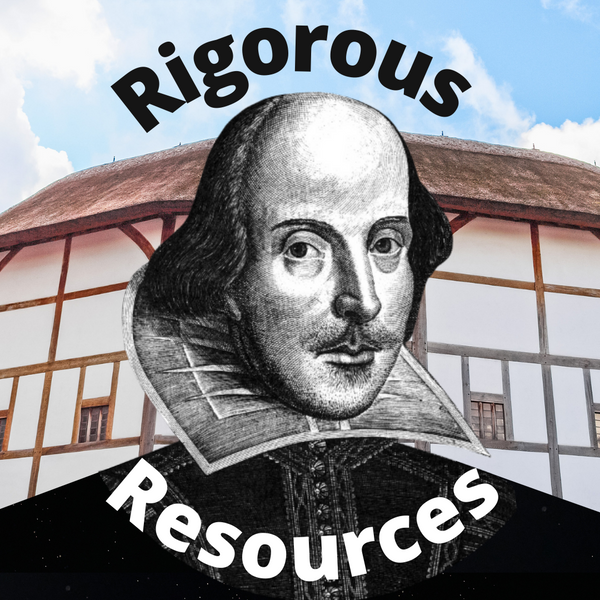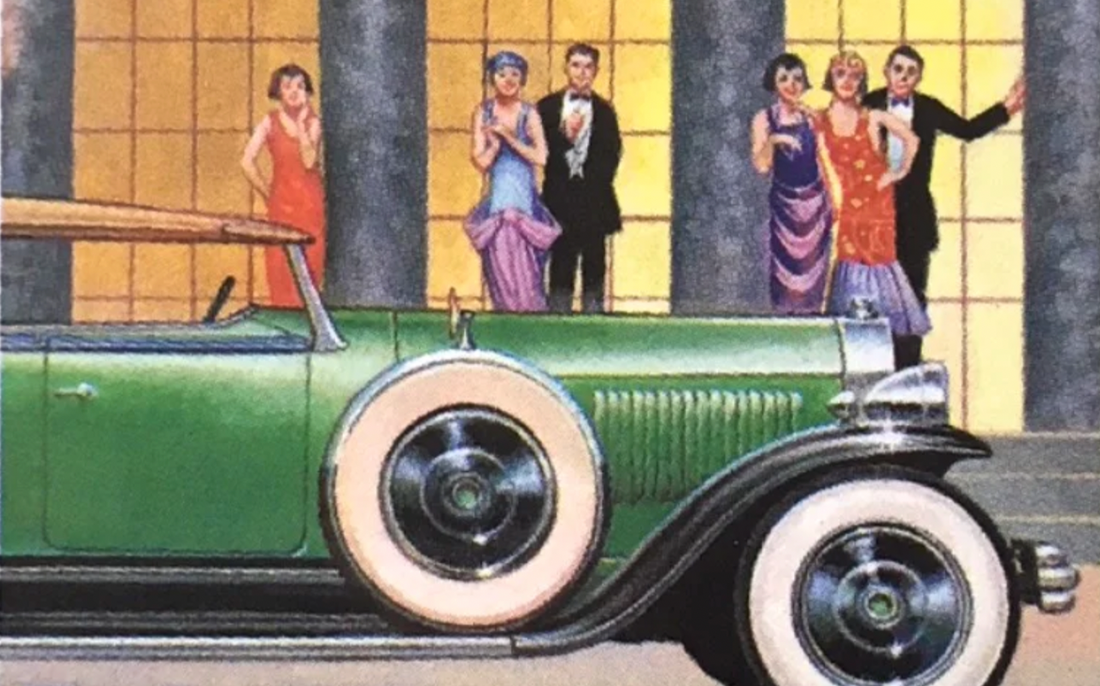Automobiles play a central role in both the plot and the symbolic meanings which Fitzgerald develops in The Great Gatsby. When analyzing the significance of automobiles in this novel, it is important to remember that automobiles were still a relatively new invention in the early 1920s. Because they were bulky machines which could travel at fast speeds, automobiles were capable of causing unprecedented damage to the human body.
During the Roaring Twenties, how were Americans adapting to the spread of mechanized technology? Does Fitzgerald depict Americans as willing to shoulder the ethical responsibility that comes with driving large vehicles? How do his depictions of careless drivers enable Fitzgerald to expose the moral recklessness of the modern era?
If you’re a teacher who’d like to explore the motif of automobiles and reckless driving with your students, then you’ll definitely want to check out this Complete Teaching Unit on The Great Gatsby. Save yourself hundreds of hours of prep time while amplifying student engagement with this Complete Teaching Unit on The Great Gatsby!!
Car Accident #1: Abdicating Responsibility
In Chapter 3, as Nick is leaving the party at Gatsby’s house, he encounters a car — a “new coupé” — which has veered into the ditch and lost a wheel (53). When the driver of the vehicle finally opens the door, he seems incapable of comprehending that he may have been responsible for driving the car off the road. The driver inquires, “Wha’s matter? […] Did we run outa gas?” (54).
The driver’s confusion and slurred speech reflect that he is drunk; but the man also seems to have a very limited understanding of how automobiles operate. Not only does he take a long time to exit the vehicle, but upon doing so he exclaims, “At first I din’ notice we’d stopped” (55). This statement reflects that the driver has no awareness of his own agency or responsibility for controlling the trajectory of the vehicle. He may harbor an outdated and dangerous assumption that driving a car is no different from being a passenger on a commuter train. When onlookers point out that “wheel and car were no longer joined by any physical bond,” the man continues to act as if the vehicle has merely run out of gas, asking, “Wonder’ff tell me where there’s a gas’line station?” (55).
The narrator proceeds to describe the car which has crashed into the ditch as being “violently shorn of one wheel” (53). Later, the narrator describes this wheel as having been “amputated” (55). Why might Fitzgerald refer to the car’s detached tire as an “amputated wheel” (55)? By using a word that is typically applied to human appendages such as arms and legs, the narrator may be suggesting that the driver is lucky that the car did not cause bodily harm to persons inside or outside the car. This message is amplified by an onlooker who exclaims, “You’re lucky it was just a wheel!” (54). By the end of the novel, of course, the appendages which get “amputated” will be more than just wheels.…
But there’s another significant reference to automobiles toward the end of Chapter 3 when Nick invokes the notion that drivers bear a moral responsibility to drive carefully. After accusing Jordan of being a “rotten driver,” Nick elaborates, “Either you ought to be more careful, or you oughtn’t to drive at all” (58). Jordan responds to this accusation by asserting that she doesn’t need to be careful because “other people are,” explaining, “It takes two to make an accident” (58). Of course, anyone who has taken a driver-education course knows that the opposite is true: it only takes only one careless driver to cause an accident. That’s why new drivers are instructed to remain vigilant about what other drivers on the road are doing.
Nick responds to Jordan’s statement by cautioning, “Suppose you met somebody just as careless as yourself” (58). What’s ironic about Nick’s statement is that everyone Jordan knows is careless — not least Tom and Daisy Buchanan. Nick Carraway may be the single exception to the carelessness that seems to infect the people in his social circle. Interestingly, Nick uses a driving metaphor when he asserts that he’s acting ethically by refraining from getting involved in a romantic relationship with Jordan: “I am slow-thinking and full of interior rules that act as brakes on my desires” (58).
Finally, automobiles are also connected to the theme of mechanization that emerges in these early chapters. How do automobiles resemble the spring-loaded “ash-tray” that Myrtle Wilson dreams of buying (36)? How do automobiles resemble the juice-extracting machine in Gatsby’s kitchen that need only get pressed by a “butler’s thumb” (40)?
Like those other machines, the automobiles in Fitzgerald’s novel seem to be literally auto-mobile: self-moving, self-driving, auto-telic. But in the 1920s, machines and automobiles were not endowed with a capacity for rational judgement or ethical decision-making. So this novel’s concern about careless driving may be related to a more general concern about who was controlling the literal and metaphorical machines within an increasingly industrial and bureaucratic society. Was the machine of industrial capitalism being driven by any logical design or set of ethical principles? Were there any breaks on that machine?
Car Accident #2: Class & Gender Exploitation
In Chapter 4, readers learn that Tom Buchanan had already been in a car accident which made its way into the newspapers. Shortly after the Tom and Daisy Buchanan returned from their honeymoon, Tom crashed into another car while driving in Santa Barbara: “Tom ran into a wagon on the Ventura road one night, and ripped a front wheel off his car” (77). Does this accident resemble the car accident described in Chapter 3? The newspapers report that Tom had been riding in the car with “one of the chambermaids in the Santa Barbara Hotel” (77). What does this detail reveal about the character of Tom Buchanan? Why might an arrogant elitist welcome a working-class woman into his car?
By this point in the novel, readers already know that Tom Buchanan is indulging in an extramarital affair with Myrtle Wilson. But the newspaper article about Tom’s joy ride with a hotel chambermaid reveals that Tom is a serial adulterer. In fact, it reveals that Tom began cheating on his wife just weeks after the newly married couple returned from their honeymoon!
But what’s equally disturbing is that Tom has been sexually exploiting women who come from a lower socioeconomic position. His actions reveal that he views working-class women as exploitable and expendable. If you’re a teacher whose students are slow to pick up on this revolting dimension of Tom’s behavior, you might ask this follow-up question: Do you notice anything similar about the types of women whom Tom takes for a ride? What price does the hotel chambermaid end up paying? What’s the author’s message about how Tom’s moral recklessness impacts working-class women? Needless to say, these questions will pack an extra punch after students finish reading the entire novel!
Tom Buchanan’s car accident resembles the car accident outside of Gatsby’s party insofar as both accidents result in a wheel becoming detached from the body of the car. But Tom’s accident also results in damage to a human body insofar as the passenger’s arm gets broken: “The girl who was with him got into the papers, too, because her arm was broken” (77). So by including this second automobile accident in his novel, Fitzgerald connects careless driving with the immoral treatment of other people — ranging from wealthy wives to working-class women like the unnamed chambermaid.
Car Accident #3: The Novel’s Climax
Needless to say, the theme of automobiles and reckless driving culminates in with the scene in Chapter 8 when Daisy Buchanan drives Gatsby’s car along the road from Manhattan to her mansion in East Egg. Daisy’s automobile accident is the third and final automobile accident which takes place in The Great Gatsby. Over the course of the novel, the negative repercussions of these automobile accidents increase gradually, culminating with a crash which causes the death of at least one character.

In this blog post, I won’t elaborate on the many parallels which Fitzgerald creates between this climactic scene and previous moments of reckless driving. But my Complete Teaching Unit on The Great Gatsby features numerous discussion questions on this climactic scene as well as detailed answer keys which reveal how and why the scene is significant.
The ways which Tom and Daisy Buchanan behave in the aftermath of this final accident will provide the basis for Nick’s devastating critique of the moral recklessness of the wealthy in the modern era: “They were careless people, Tom and Daisy — they smashed up things and creatures and then retreated back into their money or their vast carelessness, or whatever it was that kept them together, and let other people clean up the mess they had made.…” (179).

Teach It Today!
Teachers who’d like to explore the theme of automobiles, reckless driving, and moral decay will definitely want to check out this Complete Teaching Unit on The Great Gatsby. The 200-page resource packet is filled with discussion questions, vocabulary lists, and reading quizzes for every chapter of The Great Gatsby. It features a slideshow on Fitzgerald’s life as well as special-topics worksheets on symbolic settings, literary devices, color symbolism, socioeconomic hierarchies, and lots more!
Save yourself hundreds of hours of prep time while motivating your students to be highly engaged. Check out the Complete Teaching Unit on The Great Gatsby!!

